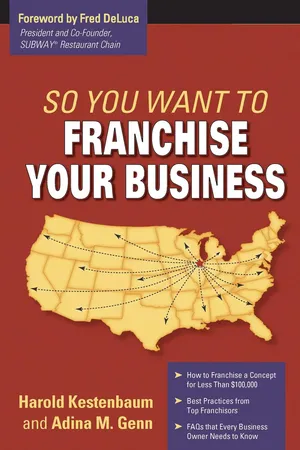![]()
PART
I
Why Franchise?
![]()
CHAPTER
1
The Benefits of Franchising
Let’s say you own a gym. Not just any gym, but the best gym in town—that’s what your clients and trainers tell you. You aptly named the gym “Fit,” and the moniker doesn’t just describe your clients, it depicts your business. The place is immaculate, well located, and features the best equipment. No wonder the place is humming from 6 A.M. to 10 P.M.
The gym practically runs itself. Your trainers are the finest in the area and they know how to treat customers. Your services are priced fairly. Your programs are scheduled to attract early-morning commuters, moms, kids, athletes, and the corporate crowd. And your marketing plan works like clockwork, enticing folks to keep their New Year’s resolution in January, shape up for spring in March, and take advantage of cool summer specials in June.
One day, you have a vision. You imagine your gym not just in your town, but in the next town over. And the town beyond that. And in the next county. OK, throughout the entire region. Suddenly, you envision going national, even international.
For a moment, it all seems possible. You could simply duplicate your fool-proof operation so that there are hundreds of well-located, immaculate Fit gyms not around the country, but across the globe. Then reality sets in. Where would you get the capital? A bank? Maybe a banker would loan you the money to open a second location. But to expand rapidly? Not so likely. Venture capital? That could mean giving away the farm, which is what most early venture firms would expect in return. Plus, you would then need to contend with the hassle of someone looking over your shoulder, telling you how to run Fit. Most entrepreneurs would not find that scenario all that appealing. We know we wouldn’t.
With franchising, people pay you for your proven business model. Even better, they pay royalties. But you will need a good concept, good management, and the right amount of capital to be successful. A franchise can be defined simply as an entity that has three factors: 1) the grant of trademark rights, 2) a prescribed marketing plan, or significant control or assistance in the operation, or a community interest, and 3) payment of a franchise fee for the right to participate.
Then it hits you: Franchising. By franchising, people will actually pay you for your tried-and-true business model so that they, too, can run a profitable enterprise. Even better, they will pay you royalties based on their sales. But does franchising really work? It has for more than 50 years and, for the most part, successfully.
The history of franchising is filled with success stories.
Ray Kroc got his start as a mixer salesman whose California clients, brothers Dick and Mac McDonald, ran a popular hamburger restaurant, McDonald’s. Mr. Kroc purchased the restaurant and transformed it into today’s giant operation through franchising. Fred DeLuca, the Subway Restaurant founder, launched his business as a 17-year-old when a family friend wrote him a $1,000 check so that he could open a sandwich shop in Connecticut. After opening 32 other Subways in the state, the company grew nationally and internationally by franchising. Tom Carvel, the famous ice cream maker, launched his business with a $15 investment, selling ice cream from a truck. Later, as a refrigeration consultant and concessionaire, he taught shopkeepers how to create his ice cream for a flat fee and a percentage of the sales—in other words, through franchising. William Rosenberg created Dunkin’ Donuts from a small “roach coach” in the Boston area. David Sandler, founder of the Sandler Sales Institute, sold his sales training program to Fortune 500 corporations as well as small- and medium-sized companies. Gary and Diane Heavin, founders of Curves for Women, grew a small chain of women’s only 30 Minute fitness centers in Waco, Texas, to an international chain of more than 6,000 such fitness centers.
Quick Stat
Franchises generate a total economic output of more than $1.53 trillion according to the International Franchise Association.
The list goes on to include a host of other franchising luminaries.
Of course, these names are legendary in the franchise world. But don’t be intimidated into thinking that franchise success stories are only attainable to a select few. Nothing could be further from the truth. With a good concept, good management, and the right amount of capital to get you started, you can build up a solid enterprise, even if you decide to grow only regionally.
Once you begin franchising, you have new responsibilities: namely, selling units and supporting your franchisees.
As the franchisor, you assume the role of working on your business, not in your business (a mantra made famous by Michael Gerber in his book, The E-Myth Revisited). If you are franchising Fit, the gym we mentioned earlier, your job is no longer the business of running the individual fitness center, but the business of finding others to open and run more fitness centers. The beauty is that these people are paying you perhaps hundreds of thousands of dollars in fees and between 4 percent and 8 percent in royalties for that privilege—and that they are earning a living as well.
In 2006, more than 300 small-business concepts adapted the business-format model of franchising, demonstrating a continued increase in the industry’s growth, according to a report issued by the International Franchise Association’s Educational Foundation. In fact, the 2000s have shown explosive growth for franchising. From 2003 through 2005, 900 new franchise concepts were launched in the United States....






